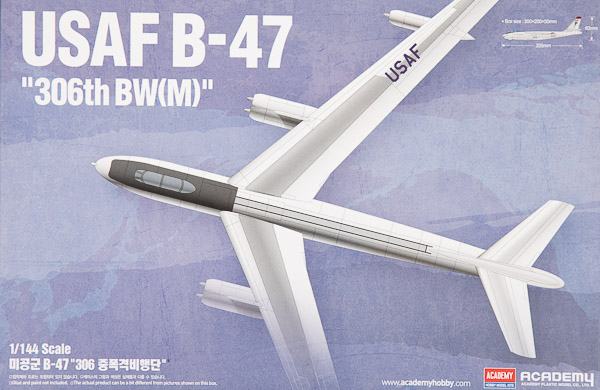
Academy 1/144 Boeing B-47 Stratojet "306th BW (M)"
By Chris Banyai-Riepl
Overview
One of the most attractive jet bombers to come out of the Cold War, the Boeing B-47 filled a role as a medium jet bomber for many years before transitioning into weather and reconnaissance work. With its sharply swept wings, tandem fighter-style canopy, bicycle undercarriage with outriggers, and six engines, the B-47 was a unique sight in the skies of the 1950s and 1960s, with the final reconnaissance type retiring in 1969 and the last testbed airframe flying until 1977.
The Kit
The Academy B-47 kit dates back quite a few years, back when it was originally released under the Hobbycraft name. At the time, you could get different boxings that could contain the early B-47B, the later B-47E, or an RB-47H. For all of these variants, the majority of the parts were identical and only a few different parts were included to cover the variant differences. For those of us who like the B-47, we had long wished for a release to come out that would contain all the variant parts. With this boxing we finally have that. Not only do we get all the various bits and pieces, but this kit comes with a decal sheet with no less than 11 different aircraft covered (done in an interesting fashion that actually lists it as seven versions). With the basic kit featuring recessed panel lines and good detailing throughout, this release is going to be the one to get.
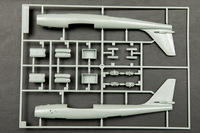
|
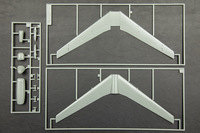
|
Jumping into the build, the starting point on this one is the cockpit. With its large tandem canopy, a fair bit can be seen and this kit helps cover that with a basic interior. There is a large floor piece, on which goes two seats and two control wheels. Nothing else is provided, but for a closed canopy finish, this will likely be enough, especially with some painted-on seatbelts. Also fitting inside the fuselage are the two separate wheel wells, and with those in place, you're immediately thrown in to decision-making time. For the early B-47B, you'll need to cut out a section of the rear fuselage and insert the RATO exhaust pieces. For the B-47E, there's not much else to do, just button up the fuselage. For the RB-47H, there are a lot of extra holes to open up for the various additions that will come later.
Next up are the wings, which also have options for the different variants. First, though, comes a universal option: the wing fuel tanks. These can be fitted to any of the aircraft, so if you choose to have these, you'll need to open up holes in the lower wing piece. For the RB-47H, you will also have to slice the wingtips off and add separate tips. The wings themselves are upper and lower halves, with the upper piece incorporating the upper fuselage section. This allows for the proper anhedral of the wings to be set while also simplifying the construction. The stabilizers are single pieces for the right and left sides. The landing gear can be added at this stage, and this is fairly well detailed for this scale. The main gear assemblies both have large, detailed main struts with a separate horizontal axle piece and oleo scissors. The main wheels are split into right and left halves for each, for a total of eight pieces for the four wheels. A separate retraction strut finishes the main gear assembly.
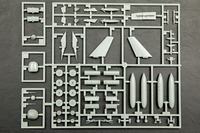
|
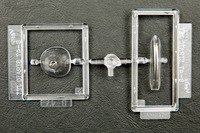
|
For the options, there are three nose options provided, a clear piece for the B-47B, a solid plastic piece for the B-47E, and a longer, more rounded piece for the RB-47H. For the B-47B, be ready to do some careful masking of the small nose windows. There is no detail provided in this area, but the windows are small enough that not much would be visible anyway, especially after painting an interior color on the piece. For the RB-47H, there are some more bits and pieces to go on the fuselage. Two large bulges fit onto the lower fuselage, and the rear fuselage sides get four additional bulges. The final option is the back end of the fuselage, with the B-47B having a different rear gun turret piece than the B-47E and RB-47H.
Back to common parts, the engines are next, and these are well engineered. For both the single engine pods and the two-engine pods, the intakes and the exhausts are molded separately as single pieces, this allows for clean edges and perfectly round intakes and exhausts. The two-engine pods are split into upper and lower halves for the middle section, with separate doors for the outrigger landing gear. The pylons are also separate. Likewise, the outboard single-engine pods have upper and lower center sections and separate pylon. Also for under the wing are the fuel tanks, which are split in right and left halves and have the two pylons separate. For the outrigger landing gear, the struts are a single assembly, with a separate door and a separate wheel. The instructions provide notes on how to adjust the height of these outriggers to have everything touching the ground.
With that all together, you get to bust out your favorite aluminum paint for this one. While it would be neat to have a camouflaged B-47, alas the only variation you get to play with on this plane is how the underside white antiflash finish was applied. Starting with the B-47Bs, you get two options for this type, one from the 306 BW(M) and one from the 305 BW, both from MacDill AFB in Florida. The 306th option has a Square P tail marking, and the 305th option has Square G. Both of these are overall aluminum, with no white undersides. Next up are three B-47Es that were the first jet bombers to cross the Pacific in 1954. All three are from the 22 BW(M) with red tail bands and no antiflash white undersides. The three options differ only in serial number.
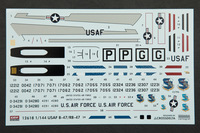
|
For the white belly birds, the first option is a B-47B updated to B-47E standard from the 305 BW(M) out of MacDill AFB in Florida. This option has a red band on the tail and minimal white undersides. The next three options are from the 320 BW(M) out of March AFB in California in 1959. All of these have more extensive white undersides that include the whole engine pods and the entire underside of the wing (although the instructions don't highlight this part). These three options also have two diagonal bands on the vertical fin. Finally, we have two RB-47H options, both from the 55th SRW. The first is from Det 2 out of Yokota AFB in Japan in 1965, while the second is from Det 1 out of RAF Upper Heyford in the United Kingdom in 1967. Both of these are overall natural metal, with no white undersurfaces, with the various antenna bits painted black.
Conclusion
If you've been waiting to pick up the Academy B-47 because you couldn't decide on which version, that decision has been made. With all options available in this one box, this is the kit to pick up. Given the broad options on the decal sheet as well, this really is a no brainer. My thanks to MRC for the review sample.
